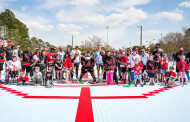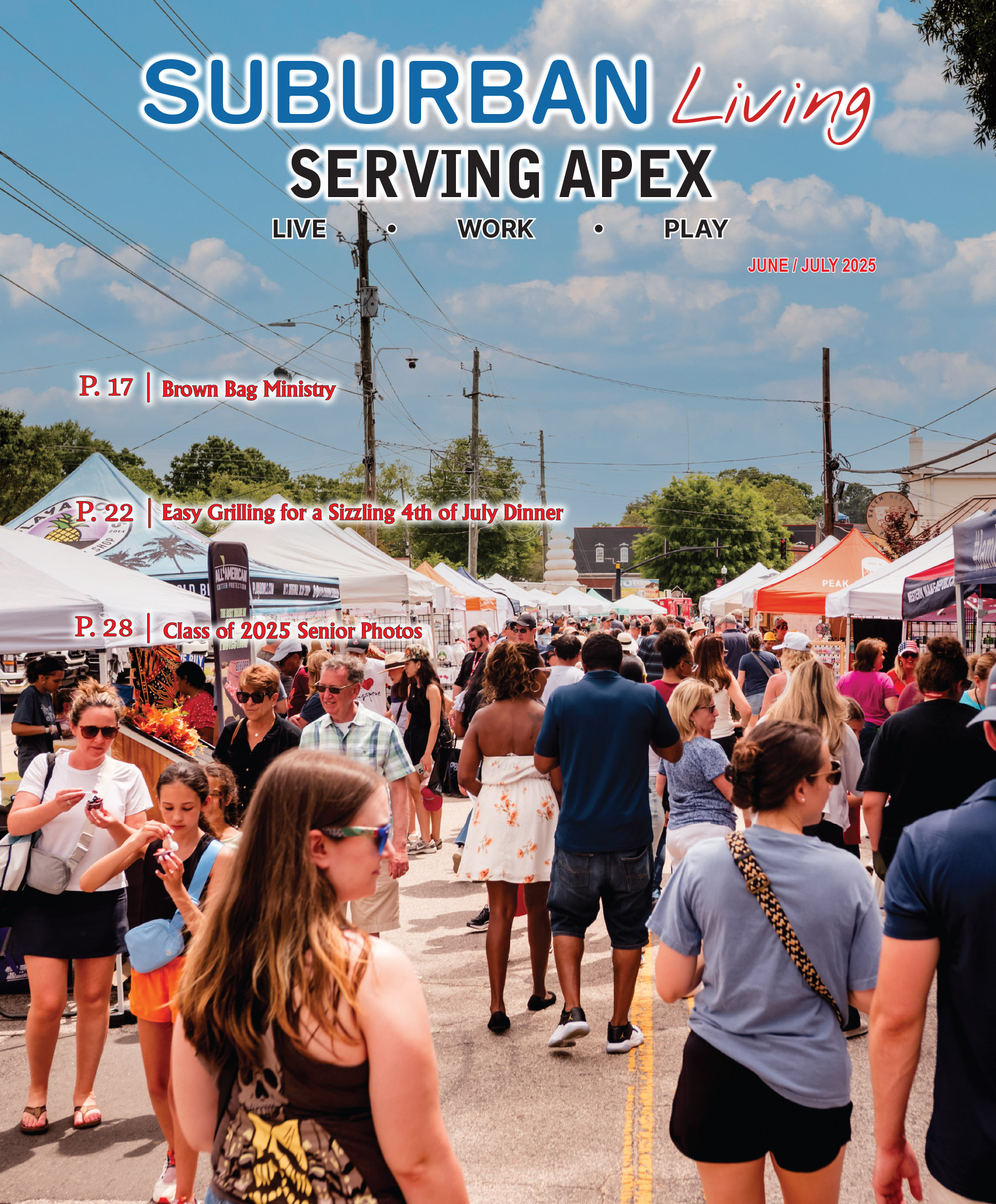“Go out and play!” Such were the words I heard my mother say every day when I was growing up. Season after season, my four brothers and I explored outdoors after school. We went camping as a family. We biked for miles and hiked in state parks. Our clothes got dirty and sometimes a bit of first aid was needed for scrapes and scratches, but we had hours of endless fun. Today, children may have busier schedules that include more in the way of music lessons and sports practice and less in the way of tadpole-catching, but it’s good to know that families are still making time for outings and activities that involve fresh air.
Every day, Apex residents walk, jog, and bike on paths through our neighborhoods. We exercise our dogs and push our strollers. We enjoy an early morning or after-work run. Some people take to the circuitous walkways available in local parks, others to the web of paved footpaths that wind through one community after another after another.
It’s no secret that fresh air, sunshine, and movement are good for our mental, emotional, and physical states of being, so whatever your reason for hitting the greenways, you’re not alone and you have plenty of pavement to choose from. Fortunately, Apex is taking its greenways seriously and trying to provide residents with improvements to existing walking trails and new paths that will link us with neighbors, shops, and even nearby towns.
Greenways Have Been, and Still Are, Part of the Plan
Now, you may be wondering how Apex can be taking its greenways seriously when there is so much growth around us. I spent some time exploring our town’s website (apexnc.org) and discovered a solid history of our town’s commitment to building and maintaining greenways. In 2013, an Apex Parks, Recreation, Greenways, and Open Space Master Plan was developed from survey feedback in which Apex residents indicated that greenways were their top priority. The report states: “[People] desire easy access to greenways from their homes, and want to be able to travel to parks, commercial centers, work, and schools on a system of well connected paths…” The Plan outlined short-term recommendations for bicycle and pedestrian routes and facilities along with user-friendly greenway maps, consistent signage, and enhanced safety measures. Near- and long-term ideas included creating and expanding a “destination-based greenway system, providing connections between downtown, commercial centers, parks, the library, Town Complex and schools.”
Fast forward a bit and 2020 is the year in which those “long-term” recommendations are due to expire and not only does Apex already have much to show in the way of progress, there are even greater plans in the works thanks to the 2017 Parks Bond for which Apex residents voted solidly (76%) in favor. This isn’t an article about tax dollars or politics, but it’s worth mentioning that prior to the 2017 vote, residents had supported parks and recreation bonds in 1996 and 2004 with an average approval rate of 80%. The results of those earlier bonds are enjoyed today in the form of Apex Community Park, Apex Nature Park and Seymour Athletic Fields, Apex Community Center, Hunter Street Park, and the Halle Cultural Arts Center.
Following the 2017 Bond, as is regular practice, Apex leaders updated current plans and drafted new long-range visions, all of which were incorporated into the town’s Capital Improvement Plan which is used to allocate financial resources among a variety of projects. It’s important to understand that when it comes to planning for an entire town and, literally, every aspect of its business, documents that describe 30-year visions, finances, and master plans have a certain amount of fluidity to them. Let’s face it, it only takes one natural disaster or unexpected community-wide crisis to force adjustments in land use and budget spending.
With that in mind, I wanted to share with you some of the projects I discovered. Not every map and document were dated, and nothing compares to seeing the earth-movers in action, but from what I can tell, Apex residents can get excited about several projects that are underway and others that are in the planning or design stages.
Beaver Creek Greenway
Currently, the Beaver Creek Greenway stretches from Kelly Road Park to Apex Jaycee Park. It looks like this year, construction will take place to complete a 1.1-mile section of mostly boardwalk that will connect Apex Nature Park to Kelly Road Park and include a walkway under the new Apex Barbecue Road bridge. When completed, the four-mile greenway will link 11 neighborhoods, three parks, three schools, and three shopping and/or business centers. Eventually, the Beaver Creek Greenway could extend even beyond the Apex Nature Park to the American Tobacco Trail at Olive Chapel Road. This later segment, named Apex West Greenway, was described as “a key link in the connection between the American Tobacco Trail and the Town of Apex” in a 2016 Wake County Greenway System Plan (which translates to potential funding assistance).
Middle Creek Greenway
Deemed a “priority regional connection” by Wake County in the same 2016 Greenway System Plan, the Middle Creek Greenway will join Apex and Holly Springs. It’s a complicated network because a section of 540 is involved, but when completed, the greenway’s 4.16 miles will travel from Center Street/Ten Ten Road (not far from Downtown Apex) to Lufkin Road Middle School, and from there to Holly Springs where the regional connection will merge with the Holly Springs greenway system at Sunset Lake Road. The project is also slated to include a connector to the high school that WCPSS has plans to build near Stephenson Road. The segments of the Middle Creek Greenway project appear to be, roughly, Sunset Lake Road to Miramonte (Phase I), Miramonte to Pemberley (Phase II), and Pemberley to Ten/Ten (Phase III).
Further down the road, both literally and figuratively, the Town of Apex may partner with the Town of Cary to create a regional link via the Swift Creek Greenway.
Swift Creek Greenway (Lower/Upper Williams Creek Greenways)
To connect Apex with our Cary neighbors, the 2016 Wake County plan identified the Lower Williams Creek Greenway as a segment of approximately 2.6 miles connecting Apex Community Park and Regency Park/Koka Booth Amphitheater. This plan is complicated by the need for pedestrian bridge crossings of US-1 and US-64. In addition, the Upper Williams Creek Greenway could someday be a 1.5-mile connection linking Apex Community Park and Fred Bond Metro Park in Cary, although significant challenges facing this segment include safe pedestrian crossings of Cary Parkway and the railroad tracks at Old Apex Road. It appears that due to funding and other constraints in Cary and Wake County, the Swift Creek Greenway is currently not a top priority, but who knows what we’ll see in coming years.
Plenty of Pavement to Enjoy Today
Don’t be frustrated if it seems like the completion of these greenways is far off. Stop and consider the many obstacles that one paved pathway must dodge in order to be safe and suitable for our use. I happen to like the image of lots of isolated sections of existing trails coming together, bit by bit, until we are all one community.
In the meantime, there are miles of asphalt, boardwalk, and natural trails already open for business. (Please note that mileage calculations are approximate.)
Apex Community Park (Laura Duncan Road): 4.17 miles of both paved and unpaved trails.
Apex Nature Park (Evans Road): 3.5 miles of both paved and unpaved trails.
Beaver Creek Greenway (Kelly Road Park to Apex Jaycee Park): 2.5 miles of paved and boardwalk trails.
Beckett Crossing Greenway (Celandine Drive): 0.3 miles of paved and boardwalk trails.
Charleston Village Greenway (Castleburg Drive): 0.35 miles of paved trails.
Haddon Hall Greenway (Haywards Heath Lane): 0.52 miles of paved trails.
Sutton Place (Holtridge Drive): .25 miles of paved trails.
There are also three local public entry points (Wimberly Road, White Oak Church Road, and New Hill-Olive Chapel Road) to the American Tobacco Trail which also connects near Green Level to the White Oak Creek Greenway and the East Coast Greenway.
Neighbors will always debate whether or not the ratio of green spaces to development is sufficient, and the existence and emergence of walking trails will appeal to some, but not all. Still, Apex residents continue to voice strong desire for more and better greenways, and town leaders are listening. Check out the Town of Apex website at apexnc.org for descriptions, maps, documents, and plans related to our greenways. Then, pump up the bicycle tires, fill a few water bottles, and harness up the dog. Call some friends and gather your family. Pick a greenway, and go out and play!








